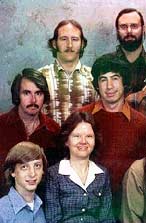|
|
|
Home > Bill Gates
As head of the all-powerful MicroSoft Corporation, Bill Gates is a man who instantly polarises opinion. Often scorned the most by the people who rely so heavily on his software and concepts, and vilified by competitors for his 'dumbing-down' of computers, Bill Gates has arguably had the single most decisive impact on how computers are used in the workplace and in the home.
 |
Born Seattle, Washington in 1955, the second-born and only male of three children, Bill Gates came from a lineage of entrepreneurship. From the start of his life he showed the energy and high-spirited liveliness of his father, an attorney. Early interests included the local aerospace industry and its 1962 World Fair, the theme of which was "Century 21". By third grade, the young Gates' intelligence was coupled with extreme behavioural problems. As he progressed through high school, his parents and teachers tried to involve him in activities that were appropriate to his obvious intellect. Upon graduation, his parents sent him to the all-male Lakeside School in an effort to improve his behaviour. Lakeside was intimately involved with the studies of usage and operating abilities of the computer. Programming became the new focus for Gates. An acute knowledge of the BASIC programming language was required, which Gates attained almost instantly. Having developed his first computer program at the age of thirteen, he soon after befriended a young Paul Allen, who was interested in the intrinsic nature of the computer. At the age of fourteen Bill Gates and his programming friend thought up the idea for a traffic counting computer, 'Traf-o-Data', which later earned them 20 000 dollars. Later, Gates was admitted to Harvard University, where he took several computer courses before dropping out. There he wrote a program for the Altair computer, the BASIC interpreter - the first basic operating language for the computer. This software was the breakthrough and beginning of Microsoft. The software Gates created for the Altair was soon to be one of his greatest contributions and beginning in the history of computer science. Later, Gates and Allen created SoftCard, which would be Microsoft's first formal invention. It was an operating system and computer language in one.
|
|
In 1980 MicroSoft purchased the rights for the Q-Dos system from Tim Paterson for $50,000, retailored it as DOS, and soon joined with IBM to create software for their computers. IBM's PC, released in August 1981, was the first time Microsoft had licensed software to a company. Gates soon began licensing to other companies like Apple, later creating the Windows 3.0 Version that would have multi-use features like graphics and spreadsheets. He also created software application program like Lotus 1-2-3 and Microsoft Works for the Macintosh. Bill Gates' creations of software and language programs became his contribution to the revolution of computers and the field of computer science. Apple released the Macintosh in January 1984. Henceforth DOS was obsolete, but still Gates became the youngest ever self-made millionaire at the age of 31. In May 1990, Microsoft finally perfected its own version of Apple windows and called it Microsoft Windows 3.0. It was a huge it. Since then, there has been Windows 3.1, 95, 98, Millennium, and NT. Gates' prediction and vision regarding personal computing have been central to the success of Microsoft and the software industry. He is actively involved in the key management and strategic decisions at Microsoft, and plays an important role in the technical development of new products. A significant portion of Gates' time is devoted solely to meeting with customers and staying in contact with Microsoft employees around the world through e-mail. Under Bill Gates' leadership, Microsoft the company's mission is to continually advance and improve software technology and to make it easier and more enjoyable for people around the world to use computers. The company is committed to a long term view, reflected in it's investment of more than $3 billion on research and in development. In 1999, Gates had wrote Business @ the speed of Thought, a book that shows how information technology can solve business problems innovatively. The book was published in 25 languages, has received wide critical acclaim and was listed on the best seller lists of the New York Times, USA Today, The Wall Street Journal and Amazon.com. |
 |
|
Useful Links Search for Bill Gates on: Please email any comments or feedback you have for this site |